Adaptability of Populus to Physiography and Growing Conditions in the Southeastern USA
Abstract
:1. Introduction
- The woody biomass proportions of stem and branches, the allometry between dimensions (height and stem diameter), and the woody biomass of poplars are affected by sites and clones.
- The biomass productivity rankings of poplar clones are affected by physiography.
- The biomass productivity rankings and adaptability of poplars (within a physiographic region) are affected by growing conditions including the marginality of lands, soil preparation, topographic positions (upslope versus downslope), and aspects of the land.
- The density, moisture content, and carbon and nitrogen concentrations of the wood of poplars are affected by site, clones, and position on trees (basal, breast height, top).
2. Materials and Methods
2.1. Description of the Study Sites
2.2. Data Collection
2.3. Data Analyses
3. Results
3.1. Woody Biomass
3.2. The Effects of Physiography on Adaptability and Biomass Productivity
3.3. The Effects of Growing Conditions on Adaptability and Biomass Productivity
3.4. Wood Properties and Composition
3.4.1. Wood Density
3.4.2. Wood Composition
4. Discussion
5. Conclusions
Author Contributions
Funding
Acknowledgments
Conflicts of Interest
References
- U.S. Department of Energy. 2016 Billion-Ton Report: Advancing Domestic Resources for a Thriving Bioeconomy. In Economic Availability of Feedstocks; Langholtz, M.H., Stokes, B.J., Eaton, L.M., Eds.; ORNL/TM-2016/160; Oak Ridge National Laboratory: Oak Ridge, TN, USA, 2016; Volume 1, 448p. [Google Scholar] [CrossRef]
- U.S. Energy Information Administration (EIA), Independent Statistics and Analysis. Wood and Wood Waste: Energy Explained, Your Guide to Understanding Energy. 2018. Available online: https://www.eia.gov/energy explained/index.php?page=biomass_wood (accessed on 18 August 2018).
- Balatinecz, J.J.; Kretschmann, D.E.; Leclercq, A. Achievements in the utilization of poplar wood—Guideposts for the future. For. Chron. 2001, 77, 265–269. [Google Scholar] [CrossRef]
- Fortier, J.; Gagnon, D.; Truax, B.; Lambert, F. Biomass and volume yield after 6 years in multiclonal hybrid poplar riparian buffer strips. Biomass Bioenergy 2010, 34, 1028–1040. [Google Scholar] [CrossRef]
- Berthelot, A.; Ranger, J.; Gelhaye, D. Nutrient uptake and immobilization in a short-rotation coppice stand of hybrid poplars in North-West France. For. Ecol. Manag. 2000, 128, 167–179. [Google Scholar] [CrossRef]
- Kaczmarek, D.J.; Coyle, D.R.; Coleman, M.D. Survival and growth of a range of Populus clones in central South Carolina USA through age ten: Do early assessments reflect longer-term survival and growth trends? Biomass Bioenergy 2013, 49, 260–272. [Google Scholar] [CrossRef]
- Stanturf, J.A.; van Oosten, C.; Netzer, D.A.; Coleman, M.D.; Portwood, C.J. Ecology and silviculture of poplar plantations. In Poplar Culture in North America; Dickmann, D.I., Isebrands, J.G., Eckenwalder, J.E., Richardson, J., Eds.; NRC Research Press, National Research Council of Canada: Ottawa, ON, Canada, 2001; Part A, Chapter 5; pp. 153–206. [Google Scholar]
- Lo, M.H.; Abrahamson, L.P. Principal component analysis to evaluate the relative performance of nine-year-old hybrid poplar clones. Biomass Bioenergy 1996, 10, 1–6. [Google Scholar] [CrossRef]
- Zalesny, R.S.; Richard, B.H.; Zalesny, J.A.; McMahon, B.G.; Berguson, W.E.; Stanosz, G.R. Biomass and genotype×gnvironment interactions of Populus energy crops in the Midwestern United States. BioEnergy Res. 2009, 2, 106–122. [Google Scholar] [CrossRef]
- Headlee, W.L.; Zalesny, R.S., Jr.; Hall, R.B.; Bauer, E.O.; Bender, B.; Birr, B.A.; Miller, R.O.; Randal, J.A.; Wiese, A.H. Specific gravity of hybrid poplars in the North-Central Region, USA: Within-tree variability and site × genotype effects. Forests 2013, 4, 251–269. [Google Scholar] [CrossRef]
- Ghezehei, S.B.; Nichols, E.G.; Hazel, D.W. Early clonal survival and growth of poplars grown on North Carolina Piedmont and Mountain marginal lands. BioEnergy Res. 2016, 9, 548–558. [Google Scholar] [CrossRef]
- Shifflett, S.D.; Hazel, D.W.; Frederick, D.J.; Nichols, E.G. Species trials of short rotation woody crops on two wastewater application sites in North Carolina, USA. BioEnergy Res. 2014, 7, 157–173. [Google Scholar] [CrossRef]
- SAS 9.4 for Windows x64 Based Systems. Available online: https://ualberta.onthehub.com/WebStore/OfferingDetails.aspx?o=56e487ad-057e-e311-93f9-b8ca3a5db7a1 (accessed on 30 January 2019).
- Pliura, A.; Zhang, S.Y.; MacKay, J.; Bousque, J. Genotypic variation in wood density and growth traits of poplar hybrids at four clonal trials. For. Ecol. Manag. 2007, 238, 92–106. [Google Scholar] [CrossRef]
- Guo, X.; Zhang, X. Performance of 14 hybrid poplar clones grown in Beijing, China. Biomass Bioenergy 2010, 34, 906–911. [Google Scholar] [CrossRef]
- Nielsen, U.B.; Madsen, P.; Hansen, J.K.; Nord-Larsen, T.; Nielsen, A.T. Production potential of 36 poplar clones grown at medium length rotation in Denmark. Biomass Bioenergy 2014, 64, 99–109. [Google Scholar] [CrossRef]
- Pliura, A.; Suchockas, V.; Sarsekova, D.; Gudynaite, V. Genotypic variation and heritability of growth and adaptive traits, and adaptation of young poplar hybrids at northern margins of natural distribution of Populus nigra in Europe. Biomass Bioenergy 2014, 70, 513–529. [Google Scholar] [CrossRef]
- Verlinden, M.S.; Broeckx, L.S.; Ceulemans, R. First vs. second rotation of a poplar short rotation coppice: Above-ground biomass productivity and shoot dynamics. Biomass Bioenergy 2015, 73, 174–185. [Google Scholar] [CrossRef] [Green Version]
- Brown, K.R.; Beall, F.D.; Hogan, G.D. Establishment-year height growth in hybrid poplars; Relations with longer-term growth. New For. 1996, 12, 175–184. [Google Scholar]
- Riemenschneider, D.E.; Berguson, W.E.; Dickmann, D.I.; Hall, R.B.; Isebrands, J.G.; Mohn, C.A.; Stanosz, G.R.; Tuskan, G.A. Poplar breeding and testing strategies in the North-Central U.S.: Demonstration of potential yield and consideration of future research needs. For. Chron. 2001, 77, 245–253. [Google Scholar] [CrossRef]
- Pliura, A.; Zhang, S.Y.; Bousquet, J.; MacKay, J. Age trends in variation of wood density and its intra-ring components of young poplar hybrid crosses. Ann. For. Sci. 2006, 63, 673–685. [Google Scholar] [CrossRef]
- Dillen, S.Y.; Marron, N.; Bastien, C.; Ricciotti, L.; Salani, F.; Sabatti, M.; Pinel, M.P.C.; Rae, A.M.; Taylor, G.; Ceulemans, R. Effects of environment and progeny on biomass estimations of five hybrid poplar families grown at three contrasting sites across Europe. For. Ecol. Manag. 2007, 252, 12–23. [Google Scholar] [CrossRef]
- Traux, B.; Cagnon, D.; Fortier, J.; Lambert, F. Yield in 8-year-old hybrid poplar plantations on abandoned farmland along climatic and soil fertility gradients. For. Ecol. Manag. 2012, 3, 228–239. [Google Scholar] [CrossRef]
- Dillen, S.; Djomo, S.N.; Al Afas, N.; Vanbeveren, S.; Ceulemans, R. Biomass yield and energy balance of a short-rotation poplar coppice with multiple clones on degraded land during 16 years. Biomass Bioenergy 2013, 56, 157–165. [Google Scholar] [CrossRef] [Green Version]
- Benetka, V.; Bartáková, I.; Mottl, J. Productivity of Populus nigra L. ssp. nigra under short-rotation culture in marginal areas. Biomass Bioenergy 2002, 23, 327–336. [Google Scholar] [CrossRef]
- Benetka, V.; Novotná, K.; Štochlová, P. Biomass production of Populus nigra L. clones grown in short rotation coppice systems in three different environments over four rotations. iForest 2014, 7, 233–239. [Google Scholar] [CrossRef] [Green Version]
- Heilman, P.E.; Ekuan, G.; Fogle, D. Above- and below-ground biomass and fine roots of 4-year-old hybrids of Populus trichocarpa × Populus deltoides and parental species in short-rotation culture. Can. J. For. Res. 1994, 24, 1186–1192. [Google Scholar] [CrossRef]
- Ceulemans, R.; Deraedt, W. Production physiology and growth potential of poplars under short-rotation forestry culture. For. Ecol. Manag. 1999, 121, 9–23. [Google Scholar] [CrossRef]
- Verlinden, M.S.; Broeckx, L.S.; Van den Bulcke, J.; Van Acker, J.; Ceulemans, R. Comparative study of biomass determinants of 12 poplar (Populus) genotypes in a high-density short-rotation culture. For. Ecol. Manag. 2013, 307, 101–111. [Google Scholar] [CrossRef]
- Jones, T.; McIvor, I.; McManus, M. Drought tolerance and water-use efficiency of five hybrid poplar clones. In Integrated Nutrient and Water Management for Sustainable Farming; Currie, L.D., Singh, R., Eds.; Occasional Report No. 29; Fertilizer and Lime Research Centre, Massey University: Palmerston North, New Zealand, 2016; pp. 1–13. Available online: http://flrc.massey.ac.nz/publications.html (accessed on 24 August 2018).
- Rancourt, G.T.; Éthier, G.; Pepin, S. Greater efficiency of water use in poplar clones having a delayed response of mesophyll conductance to drought. Tree Physiol. 2015, 35, 172–184. [Google Scholar] [CrossRef]
- Ghezehei, S.B.; Annandale, J.G.; Everson, C.S. Shoot allometry of Jatropha curcas. South. For. 2009, 71, 279–286. [Google Scholar] [CrossRef]
- Tritton, L.M.; Hornbeck, J.W. Biomass estimation for Northeastern forests. Ecol. Soc. Am. Bull. 1981, 62, 106–107. [Google Scholar]
- Pastor, J.; Abet, J.D.; Melillo, J. Biomass prediction using generalized allometric regressions for some northeast tree species. For. Ecol. Manag. 1984, 7, 265–274. [Google Scholar] [CrossRef]
- WoodProdcuts.fi. Strength Properties of Wood. Wood Products. 13 November 2013. Available online: https://www.woodproducts.fi/content/wood-a-material-1 (accessed on 9 August 2018).
- Zalesny, R.S.; Deahn, D.M.; Coyle, D.R.; Headlee, W.L. An approach for siting poplar energy production systems to increase productivity and associated ecosystem services. For. Ecol. Manag. 2012, 284, 45–58. [Google Scholar] [CrossRef]
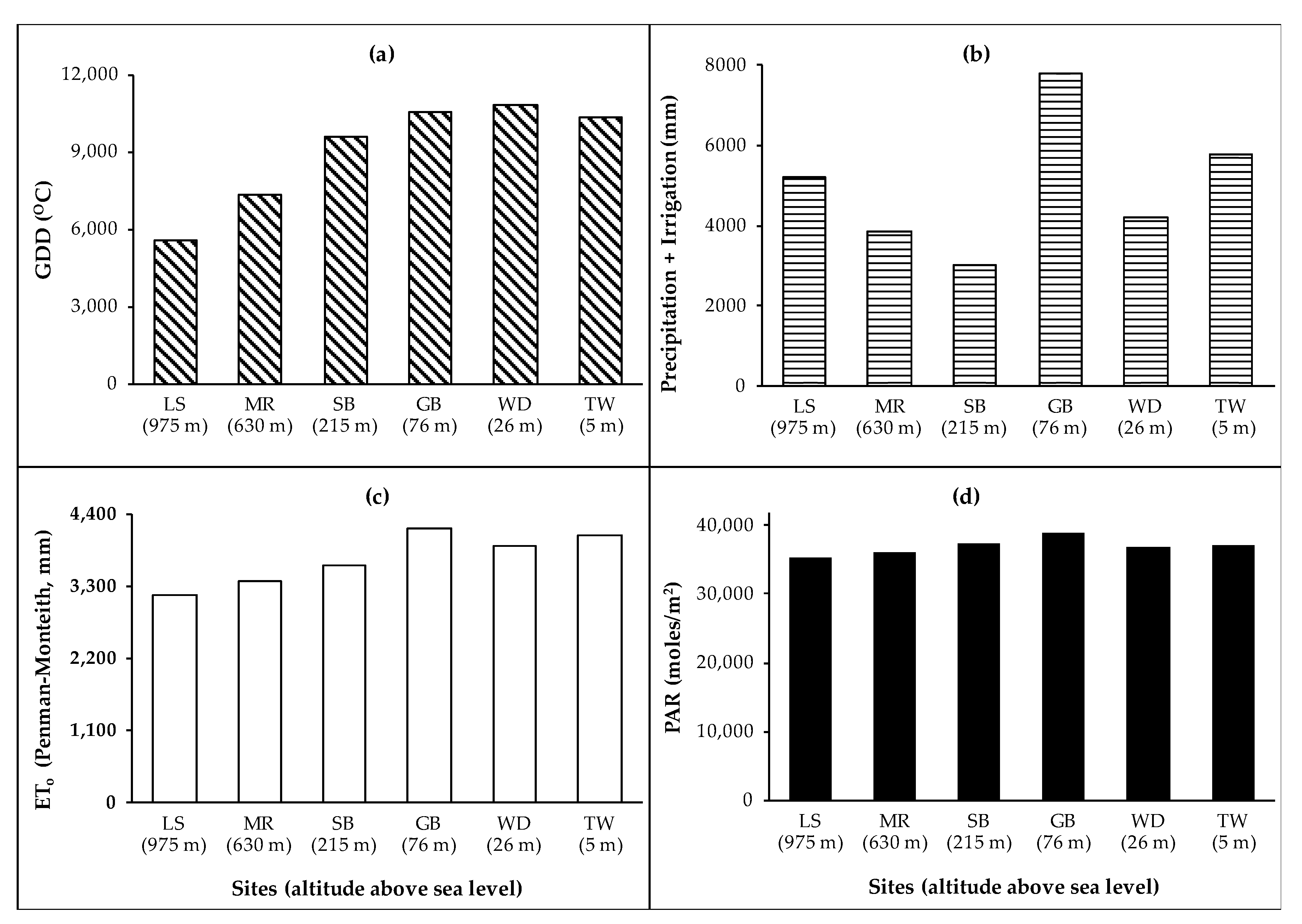
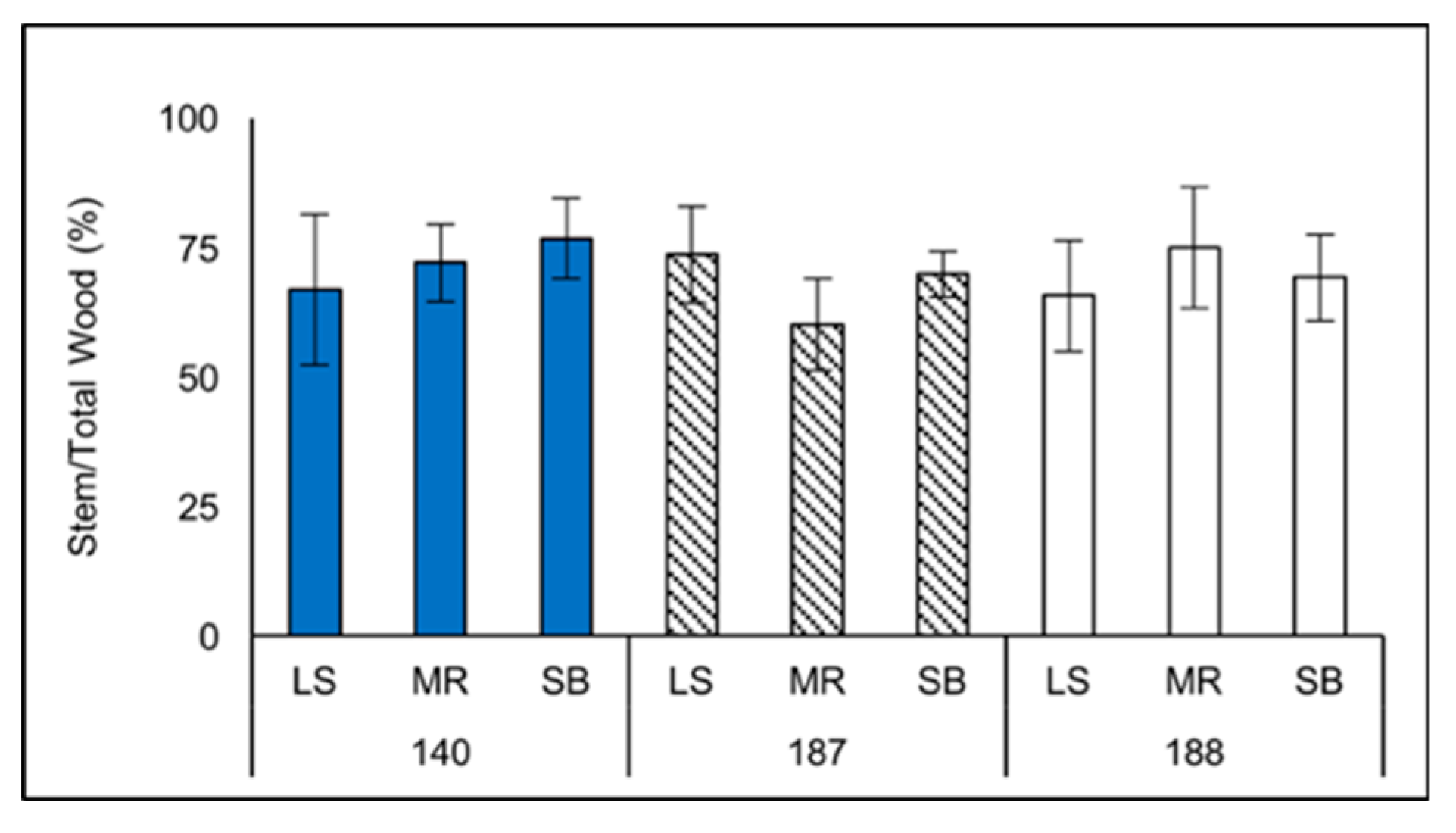


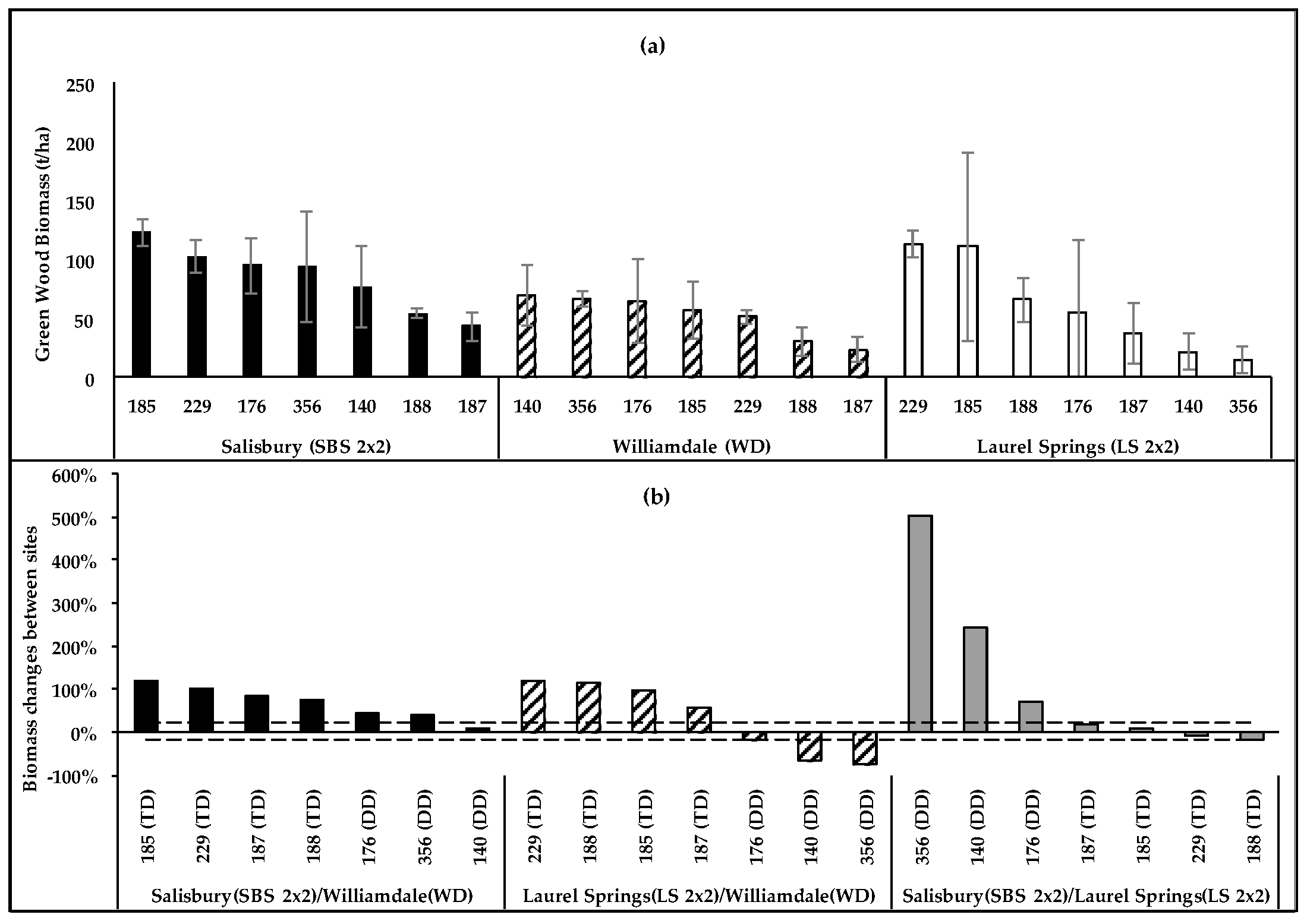
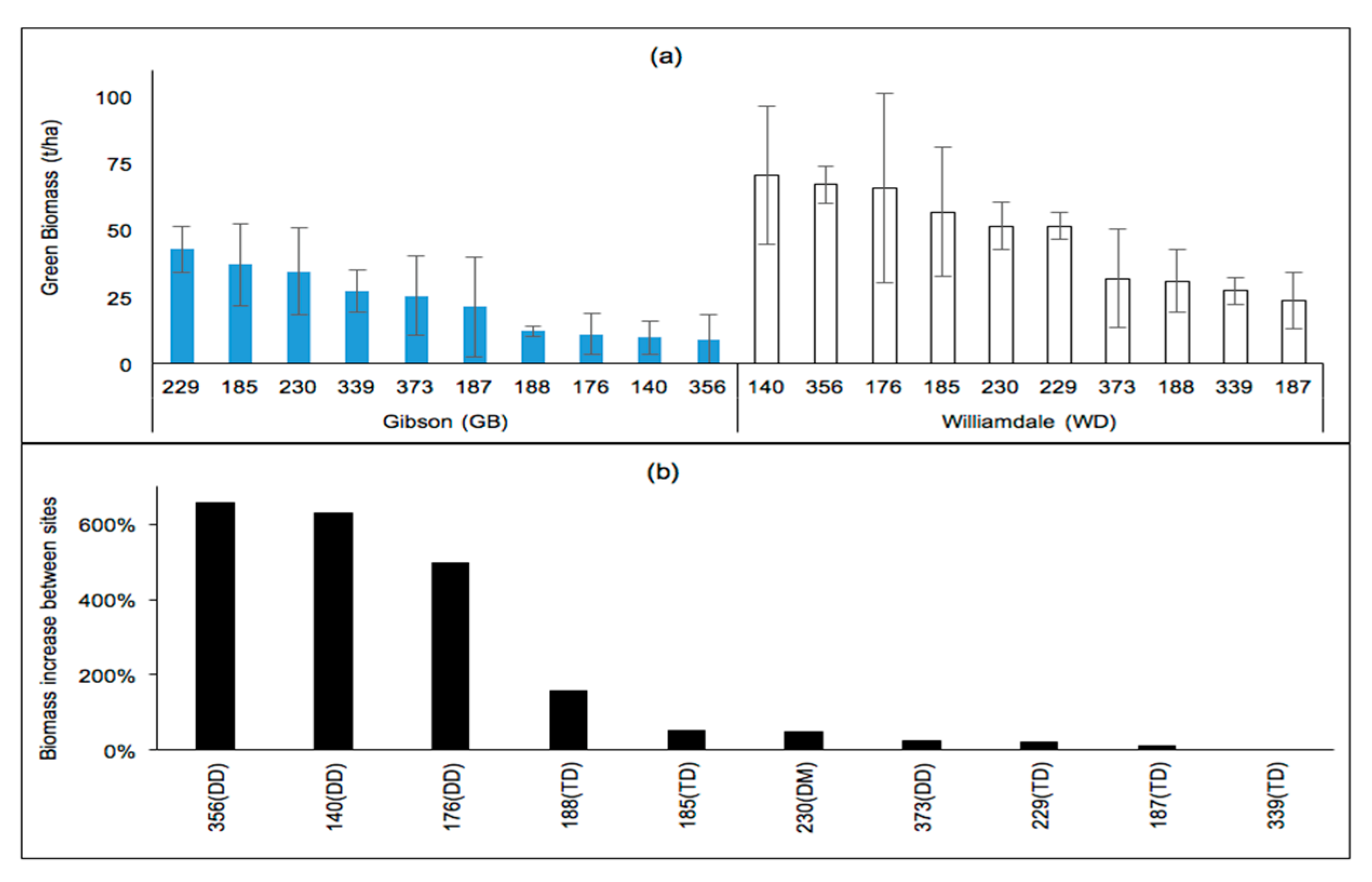


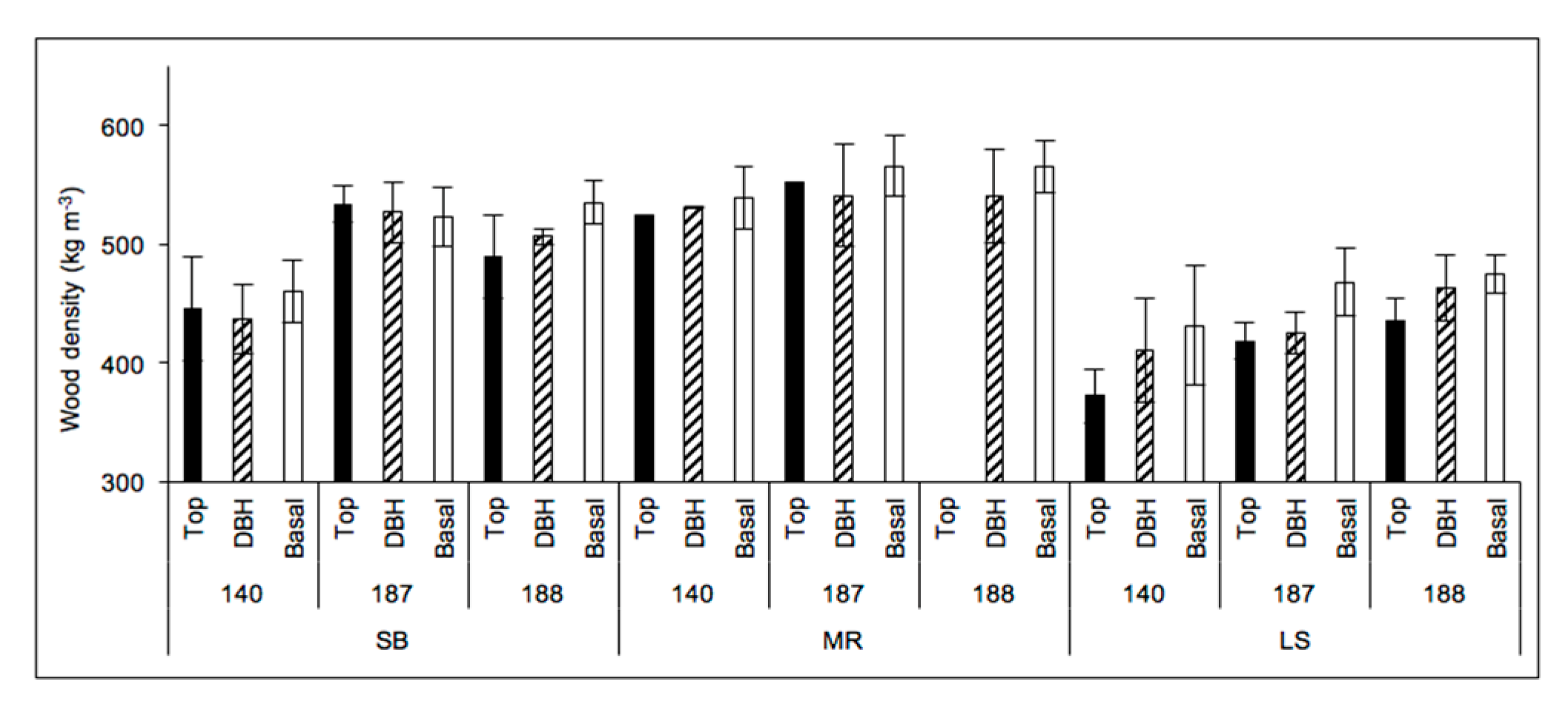
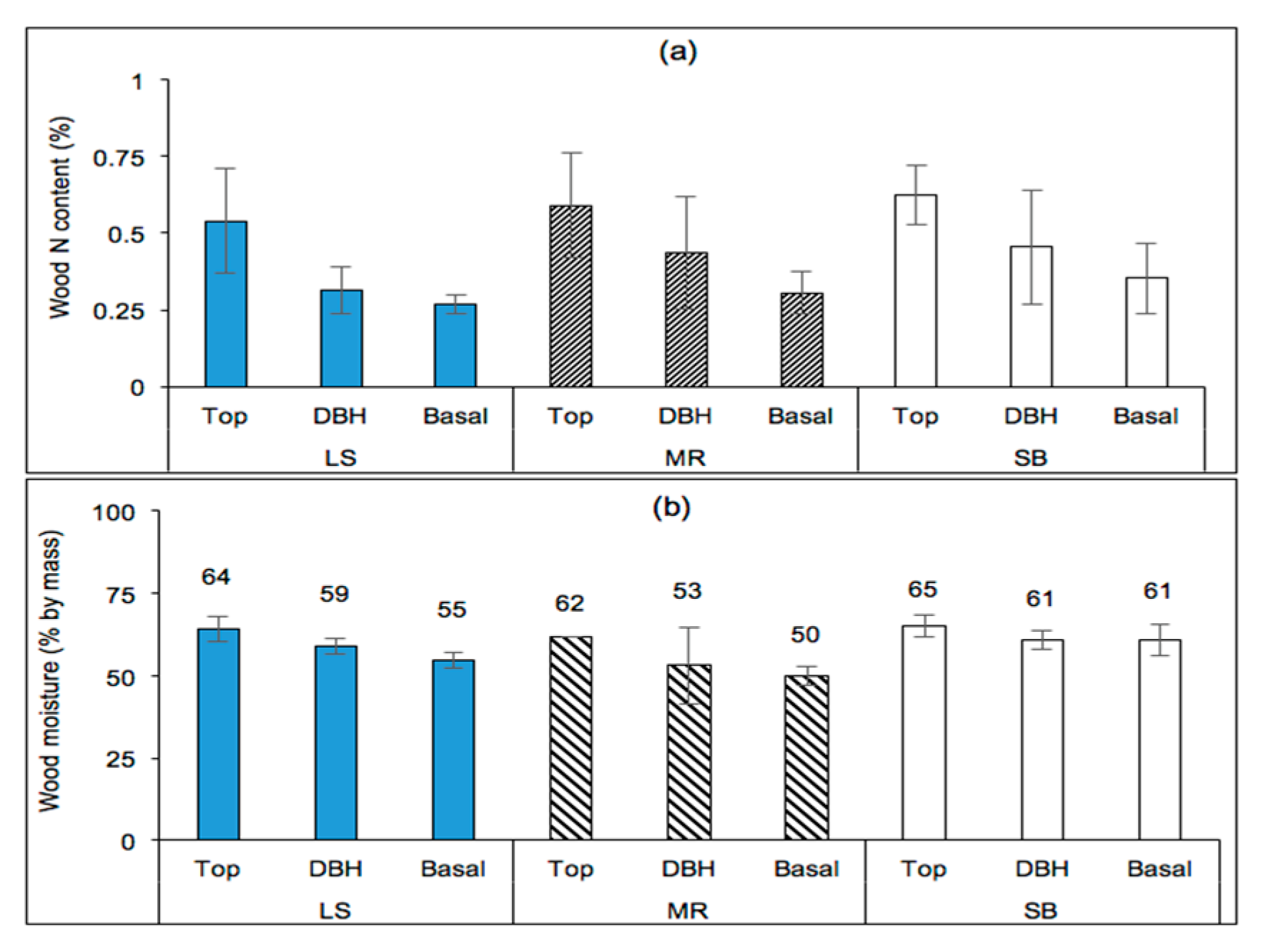
| Site; Altitude (m, above Sea Level) | Latitude; Longitude | Physiography | Precipitation; Irrigation (mm year−1) | Soil Texture | Planted |
|---|---|---|---|---|---|
| Salisbury (SB); 215 | 35.6974; −80.6219 | Piedmont | 1118 | Loam | 2014 |
| Mills River (MR); 630 | 35.4272; −82.5589 | Lower southern Blue Ridge Mountains | 1261 | Loam | 2014 |
| Laurel Springs (LS); 975 | 36.4023; −81.2971 | Upper southern Blue Ridge Mountains | 1244 | Sandy clay loam | 2014 |
| Williamsdale (WD); 26 | 34.7641; −78.0983 | Coastal Plain | 1400 | Loam | 2013 |
| Gibson (GB); 76 | 34.7672; −76.5962 | 1300; 1102 | Loamy sand | 2013 | |
| Tidewater (TW); 5 | 35.8555; −76.6508 | 1200; 550 | Loam | 2014 |
| Study Effects and Stands (Trees per ha) | Genomic Groups (Clones) | Design | |
|---|---|---|---|
| Physiography | MR (lower Blue Ridge Mountains, 2500); SBC (Piedmont, 2500) | DD (140, 177, 210, 373, 379); TD (185, 187, 188, 229, 302, 339, 342, 5077) | RBD |
| TW (Coastal, 5000); SBS2 × 1 (Piedmont, 5000) | DD (140, 312, 356); TD (187, 188, 302, 342) | CRD | |
| LS2 × 2 (upper Blue Ridge Mountains, 2500), SBS2 × 2 (Piedmont, 2500); WD (coastal, 1495) | DD (140, 176, 356); TD (185, 187, 188, 229) | ||
| Growing Conditions | Land marginality (coastal, 1495): WD vs GB | DD (140, 176, 356, 373); DM (230); TD (185, 187, 188, 229, 339) | |
| Soil preparation (coastal, 1495): WDD, WDSS | DD (140, 176, 356, 373); DM (230); TD (185, 187, 188, 229, 339) | ||
| Land topography and aspect (upper Blue Ridge Mountains, 10,000): LS1 × 1 (upper Blue Ridge Mountains) | DD (176, 210, 312, 356, 373, 379, 419, 426, 443); TD (185, 187, 188, 229, 339, 342); DM (230); DN (DN-34, OP-367) | ||
| Clone | Genomic Group | ||||
|---|---|---|---|---|---|
| Effect | F Value | p | Effect | F Value | p |
| Clone Topographic position Aspect Clone–position interaction Clone–aspect interaction Aspect–position interaction Clone–aspect–position interaction | 52.2 1.4 70.7 2.7 15.2 1.3 3.2 | <0.0001 0.2325 <0.0001 0.0002 <0.0001 0.2754 <0.0001 | Genomic group Topographic position Aspect Genomic group–position interaction Genomic group–aspect interaction Position–aspect interaction Genomic group–aspect–position interaction | 146.2 2.8 65.1 0.8 26.3 4.8 1.7 | <0.0001 0.0906 <0.0001 0.5137 <0.0001 0.0086 0.1083 |
© 2019 by the authors. Licensee MDPI, Basel, Switzerland. This article is an open access article distributed under the terms and conditions of the Creative Commons Attribution (CC BY) license (http://creativecommons.org/licenses/by/4.0/).
Share and Cite
Ghezehei, S.B.; Nichols, E.G.; Maier, C.A.; Hazel, D.W. Adaptability of Populus to Physiography and Growing Conditions in the Southeastern USA. Forests 2019, 10, 118. https://doi.org/10.3390/f10020118
Ghezehei SB, Nichols EG, Maier CA, Hazel DW. Adaptability of Populus to Physiography and Growing Conditions in the Southeastern USA. Forests. 2019; 10(2):118. https://doi.org/10.3390/f10020118
Chicago/Turabian StyleGhezehei, Solomon B., Elizabeth G. Nichols, Christopher A. Maier, and Dennis W. Hazel. 2019. "Adaptability of Populus to Physiography and Growing Conditions in the Southeastern USA" Forests 10, no. 2: 118. https://doi.org/10.3390/f10020118





